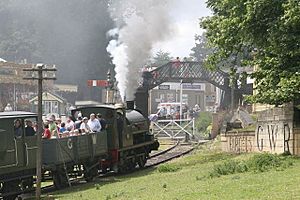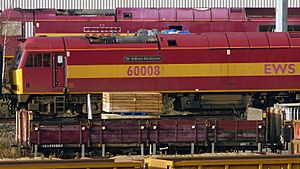Sir William McAlpine, 6th Baronet facts for kids
Quick facts for kids
Sir William Hepburn McAlpine
Bt FRSE
|
|
|---|---|
 |
|
| Born | 12 January 1936 Dorchester Hotel, London, England
|
| Died | 4 March 2018 (aged 82) |
| Nationality | British |
| Occupation | Businessman |
| Spouse(s) |
Jill Benton Jones
(m. 1959; Lady Judith McAlpine
(m. 2004) |
| Children | 2 |
Sir William Hepburn McAlpine (born January 12, 1936 – died March 4, 2018) was a British businessman. He was a director of the famous construction company called Sir Robert McAlpine. He was also known as the 6th Baronet of the McAlpine family.
Contents
Sir William McAlpine's Early Life and Work
Sir William was born in London in 1936. His family owned the Dorchester Hotel, where he was born. He was the oldest son of Sir Edwin McAlpine. Sir Edwin later became Lord McAlpine of Moffat.
Sir William's great-grandfather was "Concrete Bob" Sir Robert McAlpine. He founded the construction company that the family ran. Sir William grew up in Surrey and went to Charterhouse.
After school, he joined the family business. He started at the Hayes Depot in Middlesex. This was a large site where the company kept its railway trains and wagons. The years after World War Two were very busy for building companies.
Sir William also served in the Life Guards for two years, starting in 1954.
Saving the Flying Scotsman
In 1973, Sir William bought the famous British steam train, LNER Class A3 4472 Flying Scotsman. He saved it from being lost forever. The train had been on a tour in the United States. Its previous owner had run out of money.
Sir William brought the train back to Britain. He took care of it and ran it for many years. He wanted the public to enjoy this historic train. He owned it until the mid-1990s.
Later Life and Roles
In 1990, Sir William's father passed away. Sir William then became Sir William, inheriting his family title. He was a supporter of the Clan MacAlpine Society.
He also held the important role of High Sheriff of Buckinghamshire in 1999. He was a director and trustee for a charity called Shiplake Court Limited. This charity helps with education.
In 2007, Sir William was the president of the Smeatonian Society of Civil Engineers. He had been a member of this group since 1985. He was also president of the Railway Benefit Fund. This charity helps people who work or used to work in the railway industry.
Fawley Hill Railway: A Private Dream

Sir William loved railways very much. During the Beeching Axe, many railway lines were closed. He went back to the Hayes depot and found an old company train for sale. It was a Hudswell Clarke 0-6-0ST No.31. He bought it for just £100.
In 1961, he moved the train to his home in Fawley, Buckinghamshire. This was the start of the Fawley Hill Railway. It is a private railway that is over a mile long. It has the steepest slope on a British railway.
The Fawley Hill Railway also includes:
- A train station from the Great Eastern Railway called Somersham railway station.
- A Midland Railway signal box from Shobnall Maltings.
- A footbridge from Brading on the Isle of Wight.
Sir William also collected many old architectural pieces. He placed them around his railway line. These included flagpoles from the original Wembley Stadium. He also had old bridge parts and arched structures from London. Most of these were given to him as gifts.
You can visit the Fawley Hill Railway on special days. These visits are usually by invitation during the summer. Volunteers help to take care of Sir William's large private railway museum.
Other Railway Connections
After starting his own railway, Sir William bought another train. It was the 4079 Pendennis Castle. He later sold it, and it moved to Australia. In 1973, he bought the 4472 Flying Scotsman to save it.
Sir William also helped save the Romney, Hythe & Dymchurch Railway. He became its chairman. He also bought shares in Steamtown in 1970. He then took control of it from 1974 to 1987.
He led the Dart Valley Railway as chairman. He also started and chaired the Railway Heritage Trust. This trust helps preserve railway history.
Sir William was a supporter of the Swanage Railway Trust. He was also the President of the Transport Trust. This charity works to preserve all kinds of transport and its buildings.
Three trains have been named after him:
Sir William's Family Life
Sir William's first wife was Jill Benton Jones. They married on October 31, 1959. Jill passed away on February 9, 2004.
They had two children:
- Sir Andrew William McAlpine, 7th Baronet (born November 22, 1960)
- Lucinda Mary Jane McAlpine (born June 19, 1964)
He married his second wife, Judith, on March 25, 2004. Their wedding was at the restored station on his private railway.
Sir William passed away on March 4, 2018, after being ill for several months. His son then became the next Baronet.
Images for kids



